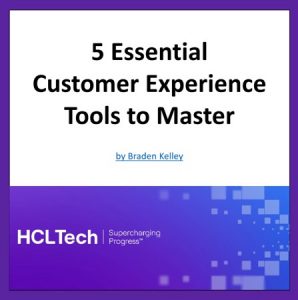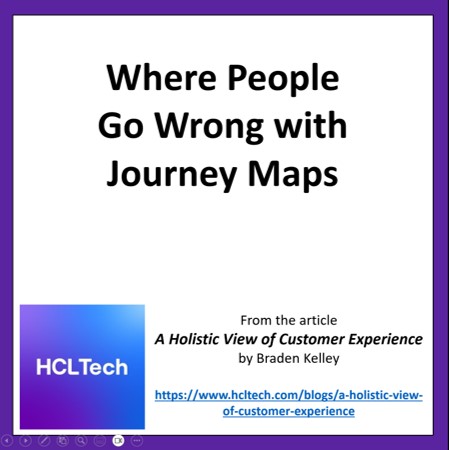
by Braden Kelley
There are so many different tools that customer experience (CX) professionals can use to identify improvement possibilities, that it can be quite overwhelming. Because CX is a human-centered discipline, it doesn’t require a lot of fancy software to do it well. Mastering these five (5) tools will help you and your customers:
1. Customer Research
Go beyond surveys and purely quantitative measures to include qualitative research that helps you uncover:
- The jobs your customers are trying to get done
- Insights across acquisition, usage and disposal
- Their most frequently used interfaces
- Their most frequent interactions
- Where customers diverge from each other on these points
2. Customer Personas (Go beyond the demographics!)
- Include THEIR business goals
- What they need from the company
- How they behave
- Pain points
- One or two key characteristics important for your situation (how they buy, technology they use, etc.)
- What shapes their expectations of the company
3. Customer Journey Maps
- Make sure you map not only the customer touchpoints and pain points, but any points where lingering actually creates value. Focus each journey map on a single customer persona.
4. Service Design Blueprints
- Uncover the hidden layers of a service’s true potential. Service design blueprints can become a visionary force to steer the course of exceptional customer experiences. Weave a masterful tapestry of intricate details into a big picture that creates a clarity of execution.
5. Customer Experience Metrics
- Every customer experience (CX) leadership team must decide how to measure changes in the quality of their customer experience over time. This could be customer churn, first-contact resolution, word-of-mouth, CSAT, customer effort (CES), or whatever makes sense for you.
Conclusion
The right set of customer experience (CX) tools will enable you to create a shared vision of what a better customer experience could look like and empower you to make the decisions necessary to create the changes that will realize the improvements you seek.
Great customer experience tools will also help you identify:
- The moments that matter most
- The tasks your employees need the most help with
- The information, interactions and interfaces that are most important to your customers
- Where different customer personas are the same and where you need to invest in accommodating their differences
- How to efficiently prioritize your CX improvement investments
Let us help you supercharge your customer experience!
Reach out to us at:
https://www.hcltech.com/contact-us/customer
Image credit: Unsplash
![]() Sign up here to join 17,000+ leaders getting Human-Centered Change & Innovation Weekly delivered to their inbox every week.
Sign up here to join 17,000+ leaders getting Human-Centered Change & Innovation Weekly delivered to their inbox every week.

 Drum roll please…
Drum roll please…
